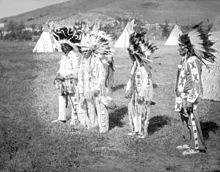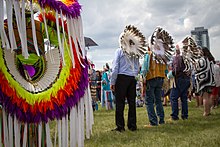War bonnet
War bonnets (also called warbonnets or headdresses) are feathered headgear traditionally worn by male leaders of the American Plains Indians Nations who have earned a place of great respect in their tribe.An honored person must have earned their feather through selfless acts of courage and honour, or been gifted them in gratitude for their work or service to their community or Nation.Several instances record how while wearing his war bonnet, he rode back and forth before soldiers of the United States Army and, despite being fired upon, was left unscathed.However, in recent years a few First Nations women who have attained a very high level of respect in their communities have been ceremonially gifted with headdresses of the type that were formerly only worn by men.[4][5][9][10][11][12][13] The controversy is part of a wider effort by Native American activists to highlight what they view as the ongoing cultural genocide against indigenous peoples in the United States and Canada.




Feather bonnetWarbonnet (paint scheme)Cheyennedog soldierpow wowHenry Maier Festival ParkfeatheredPlains IndiansregaliapeopleFort Qu'AppelleSaskatchewanwarriorDog Soldierspolitical and spiritual leadersRoman NosePlains Indian WarsheaddressesEagle feather lawInterior PlainsMigratory Bird Treaty Act of 1918federally recognized Native American tribeChildren's Museum of Indianapolisbuckskinhorsehairgolden eagleCultural appropriationNativescultural genocideindigenous peoplesUnited StatesCanadaAngela R. RileyTouphaPlume hunterPlumageIndian Country Today Media NetworkWayback MachineThe GuardianUSA TodayTeen VogueBBC News